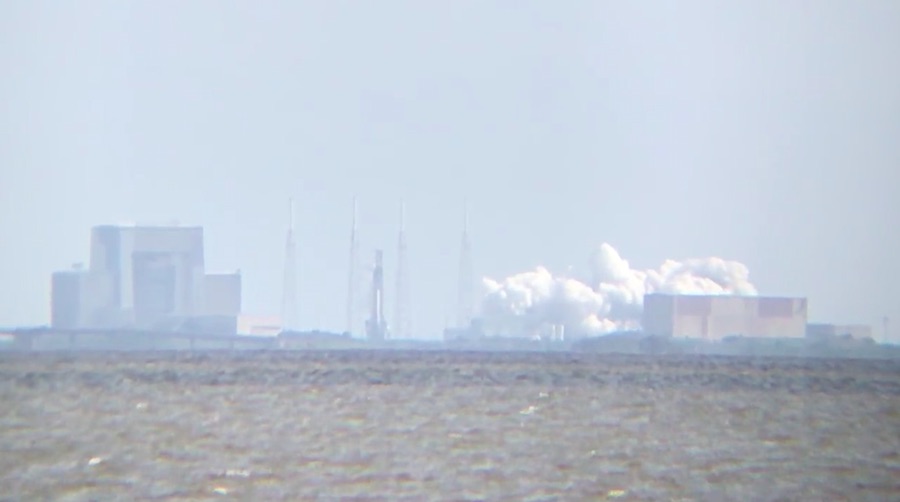
A brief test-firing of a Falcon 9 rocket Wednesday morning kept SpaceX on track for a launch Saturday night from Cape Canaveral with a communications satellite to be jointly used by Telesat and APT Satellite of Hong Kong.
The rocket’s nine Merlin 1D main engines ignited at Cape Canaveral’s Complex 40 launch pad at 10 a.m. EDT (1400 GMT) Wednesday after SpaceX engineers filled the two-stage Falcon 9 with a mixture of super-chilled kerosene and liquid oxygen.
SpaceX confirmed the static fire test in a tweet a few minutes later.
Static fire test of Falcon 9 complete—targeting September 8 launch of Telstar 18 VANTAGE from Pad 40 in Florida.
— SpaceX (@SpaceX) September 5, 2018
The mock countdown Wednesday morning occurred without the rocket’s satellite payload on-board. The next step in the launch campaign will be the lowering of the Falcon 9 from its launch mount, then the return of the launcher to a nearby hangar at the Florida spaceport.
Technicians in the hangar will mate the mission’s payload — the Telstar 18 VANTAGE communications satellite — to the forward end of the Falcon 9’s upper stage in the next few days, conduct a series of electrical and mechanical connectivity verifications, then roll the rocket back to its seaside launch pad Saturday.
The four-hour launch window opens at 11:28 p.m. EDT Saturday (0328 GMT Sunday), after several delays that pushed back the flight from last month.
A forecast issued Wednesday by the U.S. Air Force’s 45th Weather Squadron predicts a 60 percent chance of favorable conditions during Saturday night’s launch window.
“Cloudiness and showers will gradually increase over the spaceport on Friday and Saturday as an upper-level trough moves westerly across Florida,” forecasters wrote. “Low-level winds become more southerly during this time frame, enhancing the convergent band shower threat. The launch weather concerns are cumulus and thick clouds. Maximum upper-level winds will be from the northeast at 20 knots at 40,000 feet.”
Isolated rain showers are forecast to be in the area at launch time, with scattered clouds at 2,500 feet, and broken cloud decks at 15,000 feet and 25,000 feet. Good visibility, a temperature of around 78 degrees Fahrenheit, and winds of 12 to 17 mph from the south-southeast are expected.
The rocket assigned to launch the Telstar 18 VANTAGE satellite is a newly-built Falcon 9 Block 5 vehicle. SpaceX’s ocean-going landing platform has departed Port Canaveral en route for a position in the Atlantic Ocean to recover the Falcon 9’s first stage following Saturday night’s blastoff.

The Telstar 18 VANTAGE spacecraft, built by SSL in Palo Alto, California, will provide C-band and Ku-band communications services across the Asia-Pacific region from a perch in geostationary orbit nearly 22,300 miles (35,800 kilometers) over the equator.
The new satellite will launch into an elliptical transfer orbit aboard the Falcon 9, then use its on-board thruster to climb into a circular orbit, where its orbital velocity will match the rate of Earth’s rotation at 138 degrees east longitude.
Once Telstar 18 VANTAGE arrives at its operating post, it will commence a 15-year mission, beaming high-throughput signals to serve direct-to-home broadcast, video distribution, maritime, and other telecom markets. Carrying a combination of broad regional beams and high-bandwidth spot beams, the satellite’s coverage area will span from India and Pakistan in the west, to Hawaii in the east.
APT Satellite — also known as APSTAR — of Hong Kong will use 57.5 percent of the satellite’s communications capacity, in exchange for funding 57.5 percent of the mission’s total cost, officials said. The Telesat 18 VANTAGE satellite is also named APSTAR 5C, and it will replace the aging Telstar 18/APSTAR 5 telecom craft hauled into orbit by a Sea Launch Zenit 3SL booster in 2004.
In 2015, APSTAR agreed to pay $118.8 million for its share of the new Telstar 18 VANTAGE/APSTAR 5C satellite program, according to the company’s filings with the Hong Kong Stock Exchange. That suggests the total cost of the mission is roughly $206 million.
The agreement gives APSTAR use of an equivalent of 36.2 of the satellite’s total complement of 63 transponders, the company said in a statement.
APSTAR operates five geostationary communications satellites, while Telesat, headquartered in Ottawa, Canada, counts 16 geostationary telecom craft in its fleet, in addition to a pathfinder satellite for a planned broadband network in low Earth orbit.
“Telstar 18 VANTAGE is a high throughput, highly flexible, state-of-the-art satellite that will provide a significant competitive advantage to customers serving the demanding requirements of broadcast, enterprise and government users throughout Asia ,” said Dan Goldberg, Telesat’s President and CEO, in a statement released when the companies announced the new satellite program in 2015. “We are pleased to be making this important addition to our global satellite fleet and, moreover, pleased to continue our long and successful relationship with APSTAR, a leading Asian operator with whom we have closely cooperated for over a decade.”
Email the author.
Follow Stephen Clark on Twitter: @StephenClark1.



